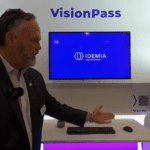
For those in the biometrics industry, IDEMIA needs no introduction. One of the largest providers of security technologies in the world, the France-based company is expert in a number of biometric modalities and a leader in the field, so it’s always worth listening when the company has something to say.
The latest comes by way of IDEMIA Biometric Devices VP of Marketing Nicolas Raffin, who spoke with FindBiometrics President Peter O’Neill in an exclusive interview. The chat kicks off with a discussion of IDEMIA’s latest big solution – the VisionPass facial recognition system for contactless access control. Raffin provides a detailed overview of the solution, and also delves into the important role that Artificial Intelligence plays in powering its performance, as well as the many application areas in which it could make an impact.
From there, the discussion moves on to the latest developments concerning another flagship biometric solution from IDEMIA – the contactless MorphoWave fingerprint scanner – and Raffin offers his views on how the industry is changing amid the COVID-19 pandemic, and a glimpse at what IDEMIA has in store for the rest of 2020.
Read the full FindBiometrics interview with Nicolas Raffin, VP Marketing, Biometric Devices, IDEMIA:
Peter O’Neill, President & CEO: Can we start off today’s discussion with information on your latest new product VisionPass? Please tell us about this.
Nicolas Raffin, VP Marketing, Biometric Devices, IDEMIA: VisionPass is our latest facial recognition system for access control. It is the successor of our previous 3D Face Reader that we used to sell. We want VisionPass to be as powerful in facial recognition as MorphoWave is in fingerprints.
To develop VisionPass, we went to see our partners and customers and we tried to get a handle on their current facial recognition needs and problems with existing facial recognition devices. After that, all the very valuable everyday issues they told us about gave us great insight for designing, engineering and manufacturing our new product. As you know we control the whole supply chain from R&D to assembly in our own plant, which I think makes us stand out from the crowd.
The bottom line is that VisionPass is a game-changing reader that meets all our customer needs. We use a very advanced 2D and 3D, plus infrared camera setup coupled with algorithms that we’ve been developing for years for the world’s most demanding government security agencies. Obviously we tap into our skills for our own devices too. Combining the best hardware and software, we have a reader which produces accurate results in most situations.
First, we give users a fully seamless experience; people don’t have to stop in front of the camera as it takes a photo; they can keep moving and it all happens in less than a second. This is really the essence of what we call ‘frictionless biometric verification’. Its speed also means we get a really high throughput of up to 30 people per minute. So, it particularly suits crowded company entrance halls where you have lots of people trying to get to their office at the same time.
Second, I would like to stress that VisionPass adapts to each person, not the other way round. The algorithm and optical setup has a very broad angle so that we can capture people from four-feet to six-feet-and-six-inches tall (1.20 meters to up to 2 meters). So people can walk normally and they don’t have to stand on tip-toe or bend down to be photographed.
Third, our customers wanted us to make sure VisionPass would also work when lighting is bright. Some install it in their office entrance halls, while others have them outdoors, in the rain, or when it’s dark during night shifts as construction firms tend to do. If you think of a hall at noon when the sun is shining, a camera can be blinded and that’s why we use infrared and very specific image processing to cope with this.
Last but not least, we took care of any security risks by embedding our latest anti-spoofing technology in our device. It now works really well against paper or smartphone photos, and even does so when people wear masks.
Peter O’Neill: Your product seems to fit a lot of the areas that we have been talking about for the past several years – frictionless, speed, anti-spoofing – these are all such critical elements. Artificial Intelligence has also become an increasingly important part of our industry. How has AI improved your throughput capacity and your whole VisionPass product?
Nicolas Raffin: Yes, you’re right to mention AI. Because we used AI to boost the performance of MorphoWave Compact, our contact-free fingerprint scanning system. Using AI in our algorithm raised MorphoWave’s accuracy and speed, especially its fingerprint image matching capabilities. This lead to faster fingerprint checks and meant it could identify damaged fingers. While MorphoWave identifies fingerprints, VisionPass obviously does faces. AI gave us better performance to deal with bright lighting, facial angles and tackling attempted spoofing.
Peter O’Neill: In this new world we’re living in with the COVID crisis, I see this as a perfect solution for many vertical markets. When you mention speed and throughput, areas like healthcare and financial services come to mind. What vertical markets are you focusing in on with VisionPass?
Nicolas Raffin: Well, in fact, we approach markets through partners we don’t sell directly to end users that include airports, production plants, hospitals, universities and head offices of banks, telecom operators or insurance companies. There are also power or mining companies who usually put gates outside. There’s really a big variety of markets; we don’t zoom in on just one.
Peter O’Neill: I’d like to talk about one of my personal favorite biometric products, and that’s your MorphoWave. I remember when I first saw this several years ago, and I think it was at ISC West, I just couldn’t believe how quick and easy it was. Can you tell us more about MorphoWave and what the latest is?
Nicolas Raffin: Our MorphoWave Compact sales pitch is a piece of cake for elevators, because it does exactly what it says on the tin! It’s a technology that we introduced five years ago, and let’s not forget it’s still unique on the market. From day one it was totally frictionless and contactless. Obviously, this device is particularly appealing in today’s ‘new normal’ as everyone’s looking for contactless solutions. With a standard reader, you put your fingers onto sensors that scan them. But with MorphoWave Compact, you just wave your hand without touching anything. It takes 3D pictures of your four fingers and scans and checks them as you wave your hand in less than a second. In fact, waving your hand in the reader maybe takes half a second. So, your four fingers are matched against a database in the device of up to 100,000 fingerprints. It’s really a piece of magic – when you wave your hand in the device, you haven’t got a clue what’s going on, it’s very quick, secure and user friendly. I think this is also a key point as it reassures users. Sometimes they’re not very comfortable with biometrics; you have to explain how it works. With MorphoWave though, it’s touchless and that’s a huge benefit. Once they’ve got how it works, they’re reassured, especially these days. The fact that you don’t have to touch or leave your fingerprints is obviously a big advantage.
In September last year we introduced an upgraded MorphoWave version tapping into latest image processing and AI advances. With this new release, we managed to boost throughput: we can now cope with up to 50 people a minute, and what’s more, we’re much better at identifying damaged fingers. In many countries and markets, we’ve got to deal with people who have very awkward or damaged fingerprints, in the construction industry for instance. We employ AI to process images in such a way that speed and accuracy are greatly enhanced.
Peter O’Neill: It’s remarkable how AI has impacted our industry over the past several years. You mentioned a throughput of 50 per minute, I mean that’s like, one per second. It’s amazing that it can actually work that fast.
Thinking about the future, after this crisis we are currently in, how do you see the identity market changing?
Nicolas Raffin: We prefer to have fewer products, but to make the ones that customers need, focusing on performances, quality and reliability. We have our SIGMA offering of touch fingerprint readers. We still see demand for them because they suit some customers’ specific circumstances and clearly they’re relatively cheap to buy. I believe there’ll still be a market for them. You might say, “But you’ve got to touch the sensor and people don’t like that”. We’ve issued recommendations how to disinfect and clean readers alongside usual instructions to wash your hands after you touch anything like a door handle or an elevator floor button. We think our customers and their staff have taken this on board.
What’s more, the future market will probably go more contactless. We’re well placed because we’re ready for that with MorphoWave and VisionPass, and we might launch other contactless products.
Peter O’Neill: Nicolas, it’s interesting, we’re hearing the same thing. I would agree with your comments that given the current crisis, the immediate reaction is, “I don’t want to touch anything”, but that will not last forever. I mean, we will be opening doors, we will be touching certain things. I think the society will change in that direction and somewhat, get back to normal. However, I do also think that your VisionPass and your MorphoWave products will experience a significant uptick, especially when it comes to speed and security.
What’s next for IDEMIA?
Nicolas Raffin: Well, I’m not going to give everything away right now but we’ve got a few more products up our sleeve that we’ll launch soon. In terms of software, we launched Augmented Vision last year at IFSEC and we plan to roll it out everywhere throughout 2020. Augmented Vision is software that you plug into a CCTV system. It adds biometrics and image analytics to existing CCTVs to provide access control, surveillance or investigation functions in real time or after the event. It’s a very powerful feature that right now is undergoing rapid change.
Peter O’Neill: Talking about accelerated change, one of the things that we’re seeing in the marketplace with the COVID crisis, is rapid change in many industries where change was already occurring, but with a two to five-year horizon; healthcare in terms of identity, for example. However, what we’ve noticed is that almost immediately, healthcare has started to move quite quickly. What might have taken two to five years is all happening right now! Are you starting to see that kind of opportunity and increased urgency across some verticals?
Nicolas Raffin: Sure, but not in just one industry. I’ve noticed that security managers are starting to get it when you talk about access control and security. A security employee badge is a must, but it’s not enough. I was recently amazed by a poll that showed a very high proportion of companies still use outdated access control technologies. Take magstripe or barcodes for example, or some old RFID technologies that can be cloned and make it really tough for security staff to spot attacks. But even with more recent badge technologies the key question is: who’s holding the badge? Is it the real holder, or was it stolen or borrowed? Companies are gradually learning that these technologies are flimsy and that they need to safeguard their assets and employees really well from attacks and their consequences. And the only way to securely authenticate people is to employ biometrics. We like to say, “Your face is your badge,” or, “Your hand is your badge” – which of-course is true.
COVID may be driving change in habits right now because people are beginning to realize they need to protect their employees and assets. But for sure, moves towards biometrics in all markets will gather pace.
Peter O’Neill: I think remote work is really pushing it all, because as everybody now works from home and is starting to use Zoom meetings, et cetera. We’re also seeing it in telehealth in Canada. The move to online doctor visits has been quite dramatic. Education is another area where everybody’s being home-schooled now. The payment market has always been very active and forward thinking in terms of identity, but we’re certainly seeing that market escalate quite rapidly as well. I think we’re in for quite interesting times over the next several years. Many of which presents some good opportunities for the identity and biometrics marketplace.
Thank you very much Nicolas. I really appreciate you taking some time for us today to talk about your new VisionPass product, which I can’t wait to see live in person at ISC West, hopefully sooner rather than later. Thank you again for your time today.
Nicolas Raffin: Thank you too. For sure, we’re really looking forward to presenting VisionPass in physical events. In the meantime, you can watch videos on our YouTube channel. We sell through partners and you can see their creativity and passion for our products in the videos they post. For example, you mentioned MorphoWave’s speed: we’ve got one New Zealand distributor who holds a chronometer and waves his hand fast back and forth to show its throughput capacity! Same for VisionPass, you can see it in action in those videos before you get the chance to see and touch it live.
Peter O’Neill: I like this NZ partner, because that’s exactly what I did when I first saw the MorphoWave product about five years ago.
Nicolas Raffin: That’s funny. They tried with butter, oil and mud that showed it works properly whatever you’re holding. VisionPass, was launched recently as you know, but we already have some partners making their own videos in total darkness or bright light. Sometimes they try to trick the device… but they can’t! This is fantastic for us because it proves that our R&D team did a very good job.
Peter O’Neill: Congratulations on the successful launch, and I hope that we get a chance to meet up at one of the upcoming conferences in the very near future.
Nicolas Raffin: Thanks Peter.







Follow Us